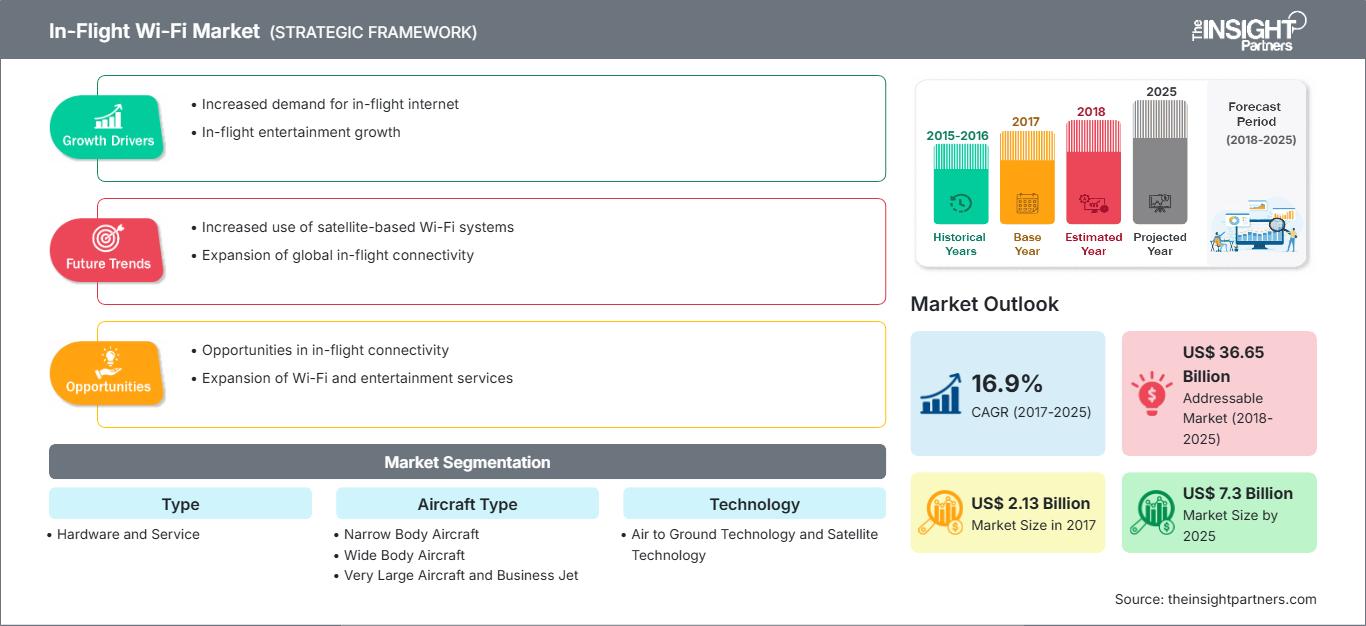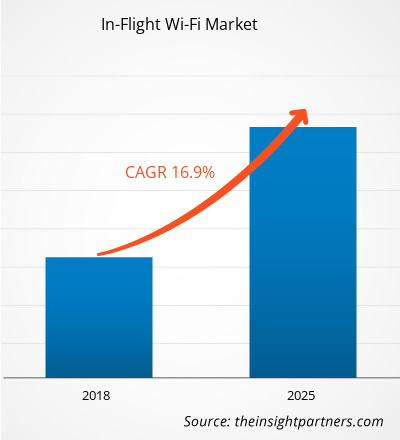Der Markt für WLAN an Bord hatte 2017 einen Wert von 2,13 Milliarden US-Dollar und soll bis 2025 voraussichtlich 7,30 Milliarden US-Dollar erreichen; für den Zeitraum 2018–2025 wird ein durchschnittliches jährliches Wachstum von 16,9 % erwartet.
In der heutigen „Always-on“-Kultur erwarten insbesondere Geschäftsreisende von den Fluggesellschaften zunehmend digitale Technologien, darunter auch Konnektivitätsoptionen an Bord. Der rasante Anstieg der Nutzung elektronischer Geräte durch Passagiere hat offensichtlich auch die Nachfrage nach Konnektivität an Bord erhöht, insbesondere auf Langstreckenflügen. Da die Fluggesellschaften zudem unter erheblichem Druck stehen, zusätzliche Einnahmequellen zu erschließen, gilt WLAN an Bord als Win-Win-Strategie, da die Mehrheit der Passagiere weltweit bereit ist, für eine schnelle Internetverbindung während Flugreisen zu bezahlen.
Auch kleinere Fluggesellschaften bieten mittlerweile WLAN-Dienste an, um mehr Kunden zu gewinnen und mit den großen globalen Fluggesellschaften konkurrieren zu können. In den kommenden Jahren wird WLAN an Bord voraussichtlich höhere Geschwindigkeiten bieten. So arbeitet beispielsweise ein Unternehmen wie Inmarsat in Zusammenarbeit mit anderen Unternehmen an einem leistungsstarken satellitengestützten WLAN-Netzwerk, das von Bodentürmen unterstützt wird. Es soll einen durchgängigen Breitbanddienst mit hoher Bandbreite in der Luft bieten. Gogo Inc., einer der größten Akteure auf dem Markt für WLAN an Bord, hat zugesichert, mithilfe von dualen Ku-Band-Antennen, die mit dem Satelliten verbunden sind, Geschwindigkeiten von bis zu 70 Mbit/s zu erreichen. Darüber hinaus wird erwartet, dass die satellitengestützte WLAN-Technologie an Bord mit verbesserten Antennen Geschwindigkeiten von bis zu 70 Mbit/s liefern wird. Mit der Luft-Boden-Technologie wird erwartet, dass Anbieter In-Flight-WLAN-Geschwindigkeiten von bis zu 100 Mbit/s erreichen. Mit der technologischen Verbesserung der Luft-Boden- und Satellitenverbindungen wird In-Flight-WLAN voraussichtlich höhere Geschwindigkeiten, ein verbessertes Erlebnis und optimale Kosten bieten. Der Markt für In-Flight-WLAN wird in den kommenden Jahren aufgrund höherer Verbindungsgeschwindigkeiten und der zunehmenden Anzahl abgedeckter Routen voraussichtlich florieren.
Passen Sie diesen Bericht Ihren Anforderungen an
Sie erhalten kostenlos Anpassungen an jedem Bericht, einschließlich Teilen dieses Berichts oder einer Analyse auf Länderebene, eines Excel-Datenpakets sowie tolle Angebote und Rabatte für Start-ups und Universitäten.
Markt für WLAN an Bord: Strategische Einblicke

-
Holen Sie sich die wichtigsten Markttrends aus diesem Bericht.Dieses KOSTENLOSE Beispiel umfasst Datenanalysen, die von Markttrends bis hin zu Schätzungen und Prognosen reichen.
Derzeit macht der Bordeinzelhandel lediglich etwa 5 % der Gesamtausgaben für Reisen aus. Dank besserer Konnektivität bieten Fluggesellschaften ihren Kunden nun auch Bordeinzelhandelsgeschäfte an. So ermöglichen Fluggesellschaften wie Swiss und British Airways ihren Passagieren beispielsweise, per Smartphone und Tablet in ihrem Katalog zu stöbern und zu bestellen. Darüber hinaus bietet die bessere Konnektivität an Bord den Passagieren ein schnelleres, einfacheres und sichereres Einkaufserlebnis, das früher nicht möglich war. Viele Fluggesellschaften sind bereits Partnerschaften mit Einzelhändlern eingegangen. So ist Air China beispielsweise eine Partnerschaft mit JD.com eingegangen, einem Online-Händler, um Hauslieferdienste und Bordeinzelhandel anzubieten. Lufthansa hat in Zusammenarbeit mit dem Supermarkt REWE ein Projekt angekündigt, das es Passagieren ermöglicht, über das WLAN an Bord Lebensmittel zu bestellen, die dann zum gewünschten Zeitpunkt an die Heimatadresse des Reisenden geliefert werden. Somit eröffnet die WLAN-Konnektivität an Bord Möglichkeiten für Einzelhandelspartnerschaften und fördert das Wachstum des globalen WLAN-Marktes an Bord.
Einblicke in Typsegmente
Basierend auf dem Typ ist der WLAN-Markt an Bord in Hardware und Service unterteilt. Der Hardwaremarkt wird weiter in Antennen, WLAN, Zugangspunkte und Hotspot-Gateways unterteilt. Der Servicebereich hingegen wird in Integrations- und Implementierungsservices, Netzwerkplanungs- und -designservices, Supportservices und Sonstiges unterteilt. Derzeit tendieren Fluggesellschaften zunehmend dazu, in ihren Schmalrumpf-, Großraum- und Businessjets WLAN-Systeme einzusetzen. Grund dafür ist die steigende Nachfrage nach Bordunterhaltung in Echtzeit mit höherer Bandbreite. Andererseits wächst auch der Dienstleistungsmarkt seit Jahren rasant, was die Nachfrage nach regelmäßiger Wartung und Instandhaltung der in Flugzeugen installierten WLAN-Systeme betrifft.
Einblicke in die Segmente Flugzeugtypen
Basierend auf dem Flugzeugtyp ist der Markt für WLAN an Bord in Schmalrumpfflugzeuge, Großraumflugzeuge, sehr große Flugzeuge und Businessjets unterteilt. WLAN an Bord ist in allen drei Flugzeugtypen installiert, um das Reiseerlebnis der Kunden zu verbessern. Von den drei Flugzeugtypen sind Schmalrumpfflugzeuge am häufigsten mit WLAN-Systemen ausgestattet, da die Flotte der meisten weltweit operierenden Fluggesellschaften sehr viele Schmalrumpfflugzeuge umfasst. Zu den führenden Fluggesellschaften, die beispielsweise 100 % ihrer Flotte mit WLAN ausgestattet haben, gehören Icelandair, SouthWest Airlines und Virgin Airlines. Southwest Airlines verfügt über 716 Schmalrumpfflugzeuge, während Emirates 256 Großraumflugzeuge mit WLAN an Bord hat. Diese Statistiken veranschaulichen die Nachfrage der Passagiere an Bord nach WLAN-Systemen.
Einblicke in das Technologiesegment
Der Markt für WLAN an Bord ist technologisch in Luft-Boden-Technologie und Satellitentechnologie unterteilt. Die Luft-Boden-WLAN-Technologie ist bei den Fluggesellschaften die am weitesten verbreitete Technologie. Das liegt an der einfachen Infrastruktur und den geringen Kosten. Andererseits bietet die Satellitentechnologie ein besseres und schnelleres Internet, ist jedoch im Vergleich zur Luft-Boden-Technologie teurer. Dieser Faktor schränkt die Fluggesellschaften bei der Entscheidung für satellitenbasierte WLAN-Systeme an Bord ein.
Die Marktteilnehmer konzentrieren sich auf Produktinnovationen und -entwicklungen, indem sie fortschrittliche Technologien und Funktionen in ihre Produkte integrieren, um mit der Konkurrenz mithalten zu können.
2018: Hughes von EchoStar kündigt Verbesserungen an seinem JUPITER™ an. System durch Hinzufügen eines schnellen In-Route-Parsing- und Priorisierungsschemas zur Unterstützung maritimer Anwendungen. 2018: Global Eagle Entertainment Inc. gab bekannt, dass All Nippon Airways Trading Co., Ltd. Global Eagle einen Dreijahresvertrag für Bordunterhaltung und Content-Dienste erteilt hat. 2018: Air Canada entschied sich für die 2Ku-Bordkonnektivitätslösung von GOGO für ihre Bombardier CS300-Flugzeuge. Mithilfe der 2Ku-Bordkonnektivität bietet Air Canada seinen Kunden die Möglichkeit, während des Fluges zu arbeiten, zu kommunizieren und sich zu unterhalten.
Regionale Einblicke in den WLAN-Markt an Bord
Die Analysten von The Insight Partners haben die regionalen Trends und Faktoren, die den In-Flight-WLAN-Markt im Prognosezeitraum beeinflussen, ausführlich erläutert. In diesem Abschnitt werden auch die Marktsegmente und die geografische Lage in Nordamerika, Europa, dem asiatisch-pazifischen Raum, dem Nahen Osten und Afrika sowie Süd- und Mittelamerika erörtert.
Umfang des In-Flight-WLAN-Marktberichts
| Berichtsattribut | Einzelheiten |
|---|---|
| Marktgröße in 2017 | US$ 2.13 Billion |
| Marktgröße nach 2025 | US$ 7.3 Billion |
| Globale CAGR (2017 - 2025) | 16.9% |
| Historische Daten | 2015-2016 |
| Prognosezeitraum | 2018-2025 |
| Abgedeckte Segmente |
By Typ
|
| Abgedeckte Regionen und Länder |
Nordamerika
|
| Marktführer und wichtige Unternehmensprofile |
|
Dichte der Marktteilnehmer für WLAN an Bord: Auswirkungen auf die Geschäftsdynamik verstehen
Der Markt für WLAN an Bord wächst rasant. Die steigende Nachfrage der Endnutzer ist auf Faktoren wie veränderte Verbraucherpräferenzen, technologische Fortschritte und ein stärkeres Bewusstsein für die Produktvorteile zurückzuführen. Mit der steigenden Nachfrage erweitern Unternehmen ihr Angebot, entwickeln Innovationen, um den Bedürfnissen der Verbraucher gerecht zu werden, und nutzen neue Trends, was das Marktwachstum weiter ankurbelt.

- Holen Sie sich die Markt für WLAN an Bord Übersicht der wichtigsten Akteure
Der globale Markt für WLAN an Bord ist wie folgt segmentiert:
Markt für WLAN an Bord – nach Typ
- Hardware
- Dienst
Markt für WLAN an Bord – nach Flugzeugtyp
- Schmalrumpf
- Großraumflugzeug
- Businessjet
Markt für WLAN an Bord – nach Technologie
- Luft-Boden
- Satellit
Markt für WLAN an Bord – nach Technologie nach Geografie
-
Nordamerika
- USA
- Kanada
- Mexiko
-
Europa
- Frankreich
- Deutschland
- Italien
- Großbritannien
- Russland
- Rest von Europa
-
Asien-Pazifik (APAC)
- China
- Indien
- Südkorea
- Japan
- Rest von APAC
-
Naher Osten und Afrika (MEA)
- Südafrika
- Rest von MEA
-
Südamerika (SAM)
- Brasilien
- Argentinien
- Rest von SAM
Markt für WLAN an Bord – Firmenprofile
- Echostar Corporation
- Global Eagle Entertainment Inc
- Gogo LLC
- Honeywell International Inc
- Panasonic Avionics Corporation
- Viasat Inc
- Sitaonair
- Thales Group
- Thinkom Solutions Inc
- Kymeta Corporation
- Historische Analyse (2 Jahre), Basisjahr, Prognose (7 Jahre) mit CAGR
- PEST- und SWOT-Analyse
- Marktgröße Wert/Volumen – Global, Regional, Land
- Branchen- und Wettbewerbslandschaft
- Excel-Datensatz
Aktuelle Berichte
Verwandte Berichte
Erfahrungsberichte
Grund zum Kauf
- Fundierte Entscheidungsfindung
- Marktdynamik verstehen
- Wettbewerbsanalyse
- Kundeneinblicke
- Marktprognosen
- Risikominimierung
- Strategische Planung
- Investitionsbegründung
- Identifizierung neuer Märkte
- Verbesserung von Marketingstrategien
- Steigerung der Betriebseffizienz
- Anpassung an regulatorische Trends






















 Kostenlose Probe anfordern für - Markt für WLAN an Bord
Kostenlose Probe anfordern für - Markt für WLAN an Bord